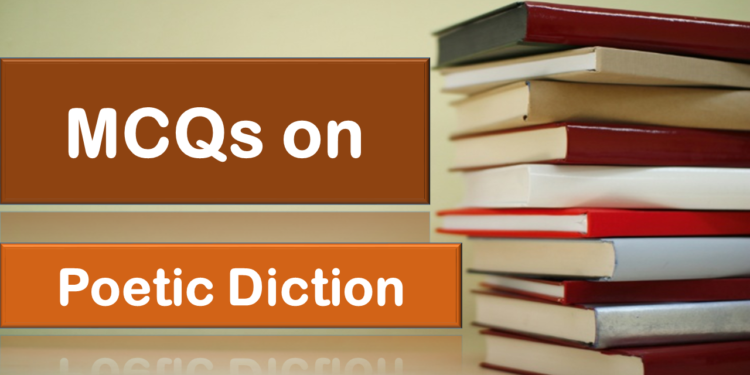50+ MCQs on Poetic Diction with Answers for UGC NET / SET Prepration
1. What does the term “poetic diction” refer to?
a. A specific way of pronouncing words in poetry
b. The language and vocabulary used in poetry
c. The rhythm and meter of poetic lines
2. In poetic diction, what is the function of archaic language?
a. To confuse the reader
b. To modernize the poem
c. To create a sense of timelessness or historical context
3. Which poetic device involves the repetition of consonant sounds at the beginning of words?
a. Assonance
b. Alliteration
c. Consonance
4. Poetic diction often involves the use of metaphor and simile to:
a. Create ambiguity
b. Clarify meanings
c. Express complex ideas in a vivid and imaginative way
5. What role does elevated language play in poetic diction?
a. It simplifies the message
b. It makes the language more complex and formal
c. It removes all figurative language
6. The use of iambic pentameter in poetic diction contributes to:
a. A regular and rhythmic flow
b. Chaotic and unpredictable versesMCQs on Poetic Diction
c. Frequent shifts in tone
7. In poetic diction, what is the purpose of enjambment?
a. To create a sense of closure in each line
b. To disrupt the natural flow of languageMCQs on Poetic Diction
c. To carry the meaning from one line to the next without a pauseMCQs on Poetic Diction
8. How does poetic diction differ from everyday language?
a. Poetic diction is more informal
b. Poetic diction is more abstract and heightened
c. There is no significant difference
9. The use of specific cultural or historical references in poetic diction can enhance:
a. Clarity
b. Ambiguity
c. Universality
10. Which of the following is an example of poetic diction?
a. “She ran quickly.”
b. “She swiftly danced through the meadow.”
c. “She moved rapidly.”
11. Poetic diction often employs unusual word order or syntax to:
a. Simplify the message
b. Create a sense of rhythm and musicality
c. Make the poem difficult to understand
12. In poetic diction, what is the function of onomatopoeia?
a. To create visual images
b. To mimic the sound of the words’ meanings
c. To simplify language
13. How does poetic diction use connotation and denotation?
a. It emphasizes denotative meanings only
b. It prioritizes connotative meanings
c. It balances both connotation and denotation for richness of expression
Also Read-
50+ MCQs on Parody with Answers for UGC NET / SET Prepration
50+ MCQs on Palinode with Answers for UGC NET / SET Prepration
50+ MCQs on Poetic Justice with Answers for UGC NET / SET Prepration
14. Poetic diction often employs heightened language to:
a. Make the poem more boring
b. Intensify the emotional impact and create a memorable experience
c. Confuse the reader with complex vocabulary
15. Which of the following is an example of poetic diction?
a. “The cat sat on the mat.”
b. “The feline perched upon the soft carpet.”
c. “The kitty rested on the rug.”
16. Poetic diction may involve the use of symbols to:
a. Make the poem longer
b. Represent abstract ideas or conceptsMCQs on Poetic Diction
c. Limit the interpretation of the poem
17. How does poetic diction use meter and rhythm?
a. It avoids meter and rhythm to maintain spontaneityMCQs on Poetic Diction
b. It employs regular patterns to enhance musicality
c. It disrupts the natural flow of language with irregular rhythmsMCQs on Poetic Diction
18. Poetic diction often employs vivid and sensory imagery to:
a. Create distance from the reader
b. Evoke emotions and enhance the reader’s experience
c. Simplify the language
19. What is the primary purpose of poetic diction?
a. To confuse the reader
b. To communicate ideas with precision and beauty
c. To limit the emotional impact of the poem
20. How does poetic diction use symbolism?
a. To restrict interpretation
b. To represent abstract ideas or concepts
c. To simplify the language
21. Which of the following is an example of poetic diction?
a. “The water is cold.”
b. “The icy liquid chills my skin.”
c. “The H2O feels frigid.”
22. Poetic diction may involve the use of allusion to:
a. Clarify the meaning for the reader
b. Reference other works, people, or events for added depth
c. Avoid engagement with external sources
23. How does poetic diction use ambiguity?
a. It eliminates all ambiguity for clarity
b. It introduces multiple interpretations to enhance complexity
c. It avoids using figurative language altogether
24. The use of vivid and specific language in poetic diction contributes to:
a. A lack of clarity
b. Enhanced imagery and emotional impact
c. A monotonous reading experience
25. Poetic diction may involve the use of personification to:
a. Depersonalize the poem
b. Attribute human characteristics to non-human entities
c. Eliminate figurative language
26. How does poetic diction use rhyme?
a. It avoids rhyme to maintain spontaneity
b. It employs rhyme for musicality and pattern
c. It relies solely on rhyme for meaning
27. Which of the following is an example of poetic diction?
a. “The mountain is tall.”
b. “The towering peak reaches for the sky.”
c. “The high hill stands above the ground.”
28. Poetic diction may involve the use of irony to:
a. Simplify the message
b. Create contrast between appearance and reality
c. Eliminate all figurative language
29. How does poetic diction use hyperbole?
a. To downplay the significance of the poem
b. To exaggerate for emphasis or effect
c. To maintain a neutral tone
30. Poetic diction often avoids clichés to:
a. Enhance originality and freshness of expression
b. Simplify the language for the reader
c. Limit the emotional impact of the poem
31. What is the role of rhythm in poetic diction?
a. To disrupt the natural flow of language
b. To enhance musicality and pattern
c. To avoid regular patterns for spontaneity
32. In poetic diction, what is the purpose of parallelism?
a. To create confusion
b. To maintain a monotonous tone
c. To balance and harmonize the structure of the poem
33. Poetic diction often employs repetition to:
a. Create a sense of monotonyMCQs on Poetic Diction
b. Emphasize certain ideas and create a rhythmic effect
c. Avoid revisiting themes or motifs
34. How does poetic diction use paradox?
a. To simplify the message
b. To create a logical inconsistency for added depth
c. To eliminate all figurative language
35. In poetic diction, what is the role of ellipsis?
a. To introduce unnecessary information
b. To disrupt the natural flow of language
c. To create a sense of omission or anticipation
36. How does poetic diction use euphony?
a. To create harsh and unpleasant sounds
b. To enhance melodious and pleasant sounds
c. To eliminate all auditory elements
37. What is the function of metonymy in poetic diction?
a. To create confusion
b. To substitute one word with another closely related word
c. To simplify language
38. Poetic diction may involve the use of chiasmus to:
a. Create confusion
b. Reverse the order of words for added effect
c. Maintain a straightforward and predictable structure
39. How does poetic diction use understatement?
a. To exaggerate for emphasis or effect
b. To downplay the significance of something
c. To eliminate all figurative language
40. In poetic diction, what is the purpose of caesura?
a. To avoid any pause or break in the lines
b. To create a sense of rhythm and musicality
c. To introduce a pause or break for emphasis or emotion
41. Poetic diction often employs the use of antithesis to:
a. Simplify the message
b. Create contrast and emphasize opposition
c. Eliminate figurative language
42. How does poetic diction use symbolism?
a. To restrict interpretation
b. To represent abstract ideas or concepts
c. To simplify the language
43. Which of the following is an example of poetic diction?
a. “The rain is falling.”
b. “The gentle drops descend from the sky.”
c. “The water droplets come down softly.”
44. Poetic diction may involve the use of paradox to:
a. Create a logical inconsistency for added depth
b. Simplify the message
c. Eliminate figurative language
45. How does poetic diction use synecdoche?
a. To create confusion
b. To substitute a part for the whole or vice versa
c. To simplify language
46. In poetic diction, what is the role of oxymoron?
a. To create a logical inconsistency for added depth
b. To simplify the message
c. To eliminate all figurative language
47. Poetic diction often employs the use of alliteration to:
a. Create dissonance
b. Emphasize the repetition of initial consonant sounds
c. Avoid any repetition of sounds
48. How does poetic diction use symbolism?MCQs on Poetic Diction
a. To restrict interpretation
b. To represent abstract ideas or concepts
c. To simplify the language
49. In poetic diction, what is the purpose of anaphora?MCQs on Poetic Diction
a. To avoid repetition of words
b. To introduce a pause or break for emphasis or emotion
c. To emphasize and create a rhythmic effect through repetition
50. Poetic diction may involve the use of irony to:
a. Simplify the message
b. Create contrast between appearance and reality
c. Eliminate all figurative language
Answer
1. b. The language and vocabulary used in poetry
2. c. To create a sense of timelessness or historical context
3. b. Alliteration
4. c. Express complex ideas in a vivid and imaginative way
5. b. It makes the language more complex and formal
6. a. A regular and rhythmic flow
7. c. To carry the meaning from one line to the next without a pause
8. b. Poetic diction is more abstract and heightened
9. b. Ambiguity
10. b. “She swiftly danced through the meadow.”
11. b. Create a sense of rhythm and musicality
12. b. To mimic the sound of the words’ meanings
13. c. It balances both connotation and denotation for richness of expression
14. b. Intensify the emotional impact and create a memorable experience
15. b. “The feline perched upon the soft carpet.”
16. b. Represent abstract ideas or concepts
17. b. It employs regular patterns to enhance musicality
18. b. Evoke emotions and enhance the reader’s experience
19. b. To communicate ideas with precision and beauty
20. b. To represent abstract ideas or concepts
21. b. “The icy liquid chills my skin.”
22. b. Reference other works, people, or events for added depth
23. b. It introduces multiple interpretations to enhance complexity
24. b. Enhanced imagery and emotional impact
25. b. Attribute human characteristics to non-human entities
26. b. It employs rhyme for musicality and pattern
27. b. “The towering peak reaches for the sky.”
28. b. Create contrast between appearance and reality
29. b. To exaggerate for emphasis or effect
30. a. Enhance originality and freshness of expression
31. b. To enhance musicality and pattern
32. c. To balance and harmonize the structure of the poem
33. b. Emphasize certain ideas and create a rhythmic effect
34. b. To create a logical inconsistency for added depth
35. c. To create a sense of omission or anticipation
36. b. To enhance melodious and pleasant sounds
37. b. To substitute one word with another closely related word
38. b. Reverse the order of words for added effect
39. b. To downplay the significance of something
40. c. To introduce a pause or break for emphasis or emotion
41. b. Create contrast and emphasize opposition
42. b. To represent abstract ideas or concepts
43. b. “The gentle drops descend from the sky.”
44. a. Create a logical inconsistency for added depth
45. b. To substitute a part for the whole or vice versa
46. a. To create a logical inconsistency for added depth
47. b. Emphasize the repetition of initial consonant sounds
48. b. To represent abstract ideas or concepts
49. c. To emphasize and create a rhythmic effect through repetition
50. b. Create contrast between appearance and reality
















